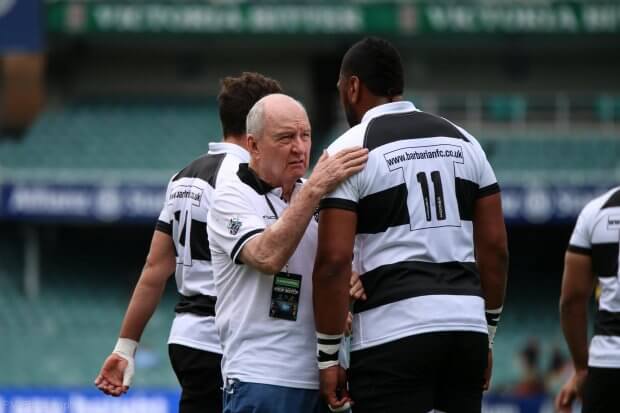Spending the last week with the Barbarians was a lot of fun and hopefully the way we played was entertaining. After all, that’s what Barbarians rugby is all about.
In a world of high performance and win at all costs rugby I know the players enjoyed having the freedom to express themselves and have some fun on the pitch. Our training was old school, and even in the warm up before the match we played touch football to ensure the players remembered the mantra for the week – ‘keep the ball alive’. In this edition we’re going to have a look at a few of the key plays from the game to make some coaching points that might be useful for young players and coaches.
Try Line Defence
The Wallabies had all the ball at the start of the game and they eventually broke down our defence with this try by Duncan Paia’aua. The biggest learning point from this clip is that whenever a team is defending the try line, the fullback must be in the defence line and the backs should be blitzing. If you try and ‘jockey’ (slide) this close to the try line the attack only have to get over the gain line to score and that’s what Duncan did in this clip. We really needed Tim Nanai-Williams to be in the defence line – we could have easily stopped this pretty soft try.
Up the Jumper
The referee was probably right to disallow this try according to Law 10.1 (b) that states: “Running in front of a ball carrier. A player must not intentionally move or stand in front of a team-mate carrying the ball thereby preventing opponents from tackling the current ball carrier or the opportunity to tackle potential ball carriers when they gain possession.”
However, in the change rooms before the game we explained our intention to use the ‘Up the Jumper’ play and the young New Zealand referee was happy. He unfortunately changed his mind when we ran it about half way through the first half. Even though the try was disallowed I think the crowd appreciated the play and our intent to entertain.
Spread Play
This next play is a ‘spread’ (wide) play that initially goes wrong but then the Barbarians support players kick into gear and a try is created because Tom Banks stayed on his feet instead of going to ground.
The one point that Alan Jones banged on about all week in our training was “stay on your feet and keep the ball alive”. This clip is a perfect illustration of that.
Banks cleans up a loose ball then stands in the tackle and Wycliff Palu takes a pop pass and he in turn pops to Nanai- Williams. who throws a “no-look” pass to big Taqele Naiyaravoro who scores the try. The most pleasing thing about this try is the amount of support around him as he crosses the line. There are another 4 Barbarians escorting him to the try line. Hopefully Taqele proved that he can play for 80 minutes and the Waratahs and Wallabies see him as a starting centre or winger. On Saturday, he only wore the 11 jersey because the 13 jersey was too small…he played at outside centre.
Momentum Shift
In the final moments of the first half Henry Speight reminded everyone of his attacking abilities by scoring a try that swung momentum in the Wallabies favour. The score was 21 v 5 when he scored this stunning individual try; had Speight not scored this try, it’s arguable the Wallabies would have struggled to run down the Barbarians in the second half.
When he receives the ball 40m from the try line he is covered by at least 3 Barbarian defenders. He not only managed to score but he was able to score close enough to the posts to make it a 7 pointer. The half time score was Barbarians 21 v Wallabies 12.
Quade’s Magic
It was a lot of fun working with the Barbarian players through the week and they really enjoyed the camaraderie that is synonymous with the invitational club. Making Quade Cooper the captain was a great signal of intent and he delivered both on and off the pitch.
Quade was the perfect go-between for the coaches and the players and he was hugely respected by the entire team. This sublime cross kick was perfectly weighted and it must be remembered that he kicked the ball on his own 22m. This piece of Cooper magic put the Barbarians back in front when everyone was expecting us to fold. It’s hard to understand why he’s not playing Test rugby anymore, because he’s the most talented Wallaby flyhalf since Mark Ella and he’s still very keen to wear the gold jersey.
Summary
The game has changed a lot since Alan Jones coached the Wallabies back in the 1980s but working with him over the past week there are 2 lessons I’ll take away:
Lesson 1 – the role of the coach is to bring out the best in every player. Man management is more important than scout reports or playbooks.
Lesson 2 – don’t burden players with instruction. Encourage them to keep the ball alive and get out of the way.

